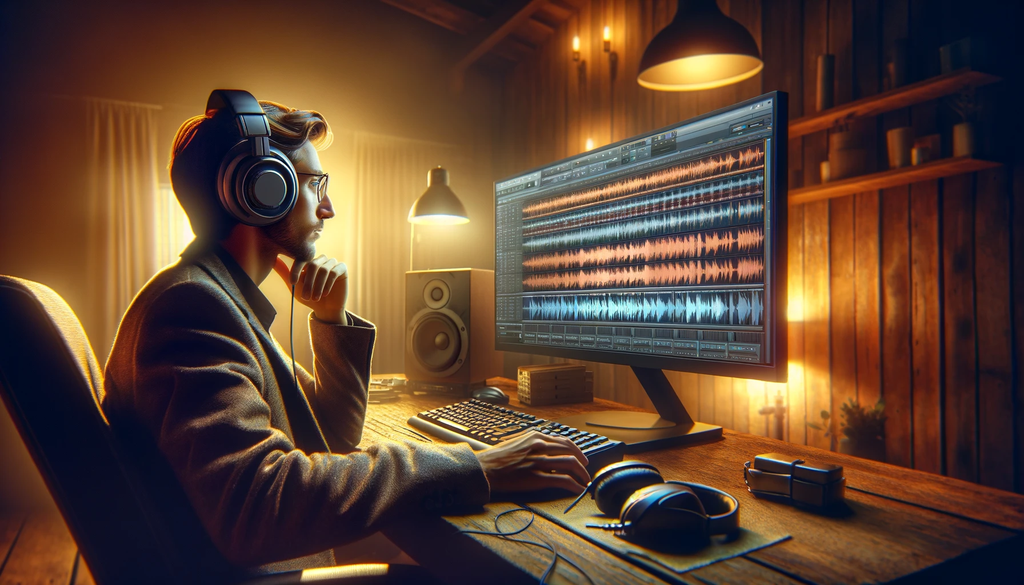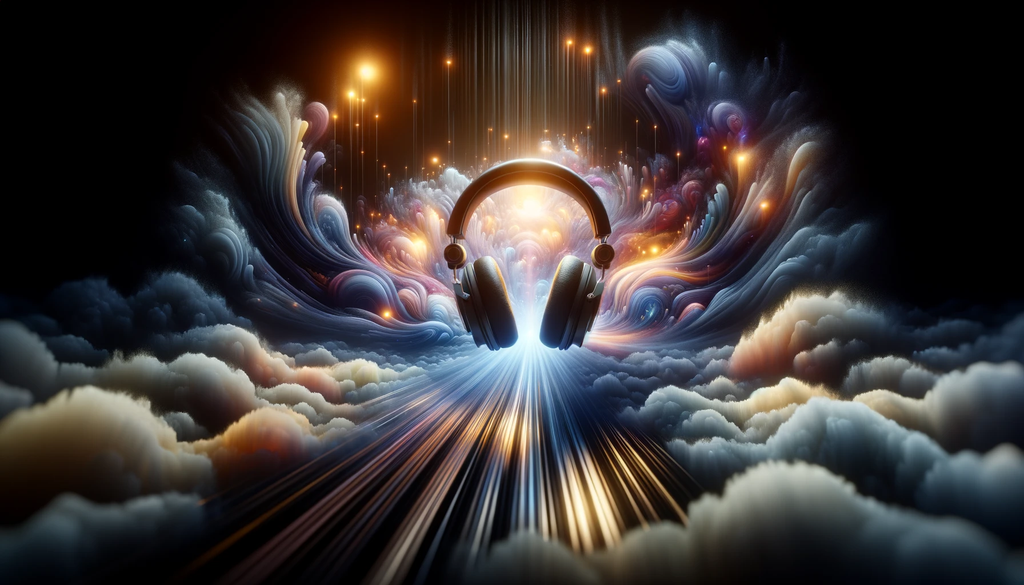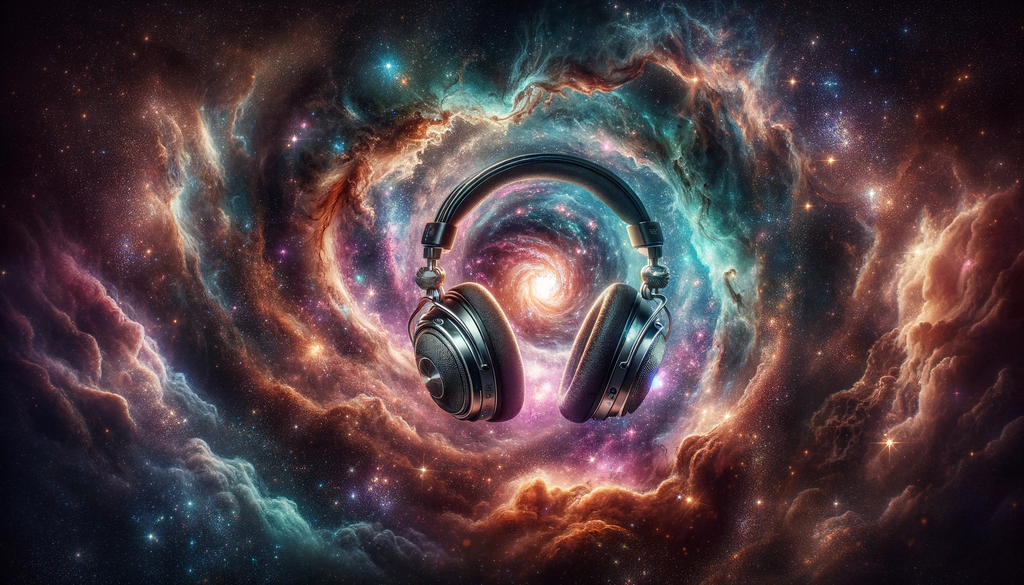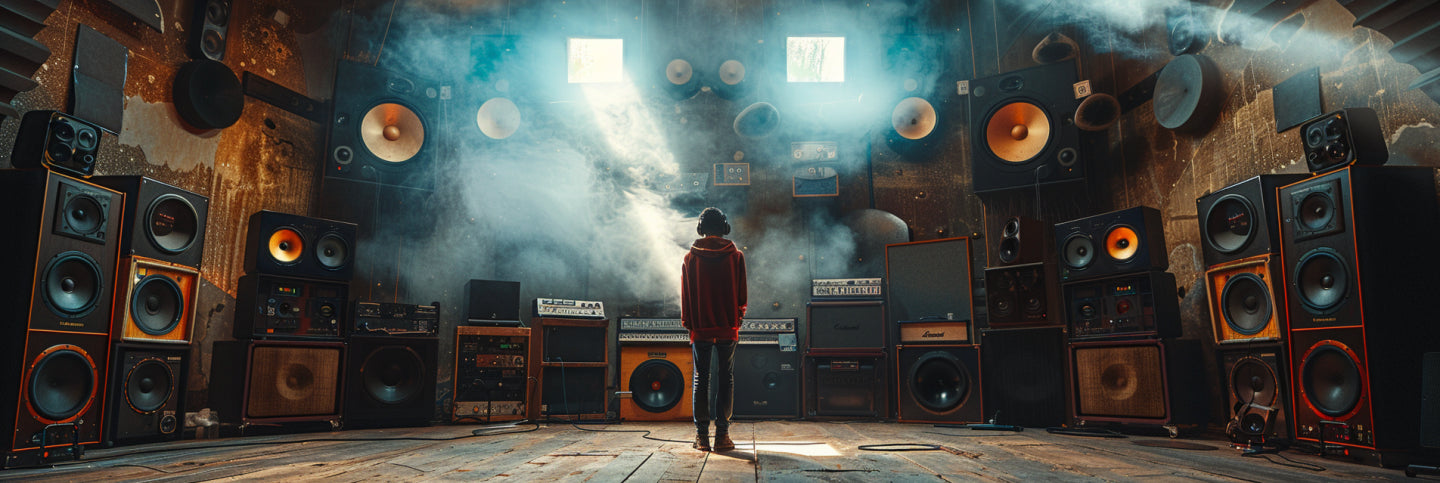When listening to music through headphones, soundstage refers to the perceived width and spatial environment of the audio. It creates a three-dimensional space where the different sounds, instruments, and vocals appear to originate and move around in. Soundstage is what gives headphones an immersive listening experience, making you feel like you are right there in the room with the musicians.
Defining Soundstage

In technical terms, soundstage refers to the stereo imaging effects that allow your brain to pick up acoustic cues which tell you the direction, distance, and size of sonic elements. It gives the auditory illusion that what you’re hearing is happening in a real physical environment. The key aspects that define headphone soundstage are:
- Width - The perceived horizontal space between the left and right audio channels. Wider sounding headphones will give a more expansive stereo image.
- Depth - The sense of space between sounds coming from the front and rear. This contributes to how layered and three-dimensional the audio feels.
- Height - On some high-end headphones you may even get some perceived vertical height, further enhancing immersion.
The combination of width, depth, and height work together to create the soundstage experience.
When soundstage is executed well on headphones it creates an out-of-head listening experience, making the music more enveloping as if you are in a room listening to a live performance. Poor soundstage will sound narrow, flat, and crunched together.
Why Soundstage Matters

Soundstage may seem like an intangible quality when shopping for headphones but it has very real effects on your listening experience:
- Creates a more immersive and holographic audio environment
- Instruments and vocals have their own space to breathe rather than blending together
- Easier to pick out micro-details and subtleties
- Adds excitement, energy and realism to music
- Sets the mood and atmosphere
- Vocals sound further from your head which enhances perceived quality
For many music lovers, audiophiles, gamers, and movie watchers, a expansive, multi-dimensional soundstage makes the experience come alive and draws you in. It’s what creates the feeling of being at a live concert or right there in the cinematic action.
In short, soundstage helps transform good headphones into great ones for deeply engaging, moving audio. When done right it's an essential part of high-fidelity listening.
What Creates Soundstage in Headphones

There are a several core factors that determine how expansive and immersive the soundstage will be on a pair of headphones:
Driver Size and Type
The drivers are the speakers that produce the sound in headphones.
- Larger-sized drivers (40mm and above) tend to reproduce wider sound with more sense of space compared to smaller drivers. There is more internal volume and surface area for the diaphragm to move air, resulting in better bass extension and a more open sound.
- Open-back driver designs, with perforations/mesh on the outer side of the driver enclosure, provide an extra spacious acoustic environment. The openness allows the sound waves to dissipate naturally rather than being reflected internally over and over within a closed shell. This expands the perceived width and depth of the soundstage.
- Closed-back drivers with sealed enclosures on the other hand limit soundstage width due to increased internal reflections. But they make up for it with punchier bass response thanks to the closed volume allowing higher pressure buildup. So there’s a tradeoff - soundstage versus bass.
- Planar magnetic drivers, seen in some high-end audiophile headphones, use a thin vibrating diaphragm with precise control across its surface. This can enable extremely fast transient response for realistic imaging and localization of sounds in the soundstage.
Earcup Design
The size, shape, and fit of the earcups impact how intimate or expansive headphones will sound:
- Over-ear headphones with large oval or round earcups that surround your ears tend to have the most potential for an immersive, speaker-like soundstage experience. Your ears have room to breathe inside the chamber and interact with the sound 360 degrees around each ear.
- On-ear headphones that press against your ears create a more forward “in-your-head” soundstage since the drivers fire sound directly into a smaller contact area covering only parts of your ears. There is less room for cross-interaction of sounds around different surfaces of the ear.
- In-ear buds inserted into your ear canals have an inherent intimacy and lack of openness. But techniques like advanced spatial audio processing with head-tracking and pinnae modeling help create the illusion of space.
- Earcups with angled drivers rather than drivers that fire straight into your ears will also aid in creating a wider, more natural soundstage. Angled drivers at 10-15 degrees mimic real-life sound incidence better.
Acoustic Engineering
The internal tuning of headphones also influences the soundstage presentation:
- Careful acoustic placement of damping material, ports, and volume spaces help shape the frequency response for a realistic reproduction of distance and room reverberation cues.
- Minimizing resonant peaks through absorptive materials in the high frequencies allows you to better hear delicate micro-details that reveal subtle performance venue environmental cues.
- Tighter bass control prevents boominess from masking those venue details.
- The circuitry and amplifier pairing also impact soundstage. Quality DACs and headphone amps with wide frequency response extension on both ends help.
It takes highly advanced engineering across all these areas to achieve truly expansive, holographic soundstage on headphones - from the driver technology to ergonomics and acoustic tuning. Paying attention to the intricate headphone hardware and engineering design is key to excellent soundstage.
Types of Soundstage

While soundstage may seem like an amorphous concept, there are distinct aspects that audiophiles look at when critiquing the “staging” abilities of headphones:
Width
This refers to the perceived lateral space between the left and right audio channels. Wider sounding headphones will give a more expansive stereo image rather than having sounds cramped together between your ears.
- Evaluating width comes down to hearing how far left, right, and center instruments and vocal elements are positioned. Well-recorded audio tracks will have directional cues by mixing in subtle delays and level differences.
- Extreme width approaches the realism of actually sitting in the audience of a concert stage or music venue space with perceptible distance between band members across the front of the stage. You feel transported right to the event.
- Good width also helps with clearly hearing stereo panning effects on recordings - as sounds travel laterally from channel to channel.
- Extremely narrow, congested width can feel unnatural and static, reducing the dynamism of recordings. You lose vital spatial information.
Depth
Depth indicates how much front-to-back space you hear in the audio along the depth plane from your head forward. It brings that third dimension making things sound more layered and dimensional rather than flat.
- Listening for depth is noticing if some instruments sound closer and more forward in the mix while others seem farther back on a virtual stage. Depth perception relies on hearing reverberation, level volumes, and frequency response shaping.
- Natural reverb on recordings will have more spatial decay with enhanced depth. As sounds reflect off virtual room boundaries at varying distances, you hear the timing and filtration effects.
- Vocals tend to highlight apparent depth as you distinguish relative distance intimacy from backup singers to lead vocalists. The balance between direct and reflected sound is noticeable.
- Lacking depth collapses all the musical elements together, loses vital space, and reduces realism - often fatiguing your ears.
Height
While not always present on headphones, perceived height adds that vertical spaciousness for even more lifelike soundstaging:
- Height helps recreate the sound you hear in actual performance spaces where reverb occurs across all surface boundaries, including ceilings and walls with height. Vertical reflections add dimensionality.
- Height makes binaural audio recordings really shine as they use HRTF techniques to actually capture full 3D soundscapes with natural elevation effects. Your brain gets cue to position sounds in space.
- You’ll hear sounds elevated higher beyond the horizontal plane slice running laterally across your ears on good cans. Cymbals shimmer above, voices project upwards, etc.
So in summary, soundstage contains a lot of psychoacoustic perceptions of width, depth, and height that ultimately help recreate the sound reflections and venue space you’d hear in a real audio event. The best headphones will transport you to the performance.
Virtual vs Natural Soundstage

When researching headphones, you’ll come across the terms virtual and natural soundstage. Here’s an in-depth explanation of the two:
Virtual Surround Sound
Virtual surround sound aims to emulate a spacious, multi-speaker playback system like 5.1 or 7.1 home theater over regular stereo headphones. Modern digital signal processing creates the illusion of surround sound.
- Uses head-related transfer functions (HRTF) - advanced psychoacoustic algorithms that simulate how sound hits our ears from various angles and distances in a room environment. Effectively tricks your brain's ability to decode spatial cues.
- Models the impact of simulated room boundaries, directional intensity/timing, frequency shaping from sound propagation distances, artificial reverberation decay tail modulation, and positional delays to replicate room acoustics with added width, depth, and height.
- Encoding requires multi-channel audio mixes as well as accurate personalized HRTF profiles. Decoding can happen on the headphone end or source playback device. Quality varies widely.
- Example surround technologies: Dolby Atmos Headphone, DTS Headphone:X 2.0, Sony 360 Reality Audio, Creative Super X-FI, etc.
- Effectiveness depends greatly on the encoding codec quality, personalization to listener, and psychoacoustic accuracy which is improving with machine learning models.
Binaural Audio
Binaural recordings are made using special microphones placed inside a dummy human head model with anatomically-precise ear canals and shaped outer ears. The torso/head act as an acoustic shadow that naturally shapes the sound through comb filtering and interference effects.
- Life-like head model captures actual spatial room information optimized for headphone listening rather than speakers.
- Requires no extra decoding or sound processing - encoded audio works as is directly in any standard stereo headphones by naturally passing through your own head model.
- Truly harnesses the left/right headphone channel separation by embedding spatial details through interaural time differences, sound volumes, phase shifts. This activates the sound localization ability in your auditory system.
- High-end binaural mic examples are the 3Dio Free Space Pro II or Neumann KU 100. Even entry-level binaural mics like Zoom H3-VR can be remarkably convincing.
Natural Soundstage
Natural soundstage relies strictly on the inherent acoustic design of the headphones themselves rather than digital processing:
- Larger-sized dynamic drivers or advanced planar/electrostatic drivers offer high transient response speed and precise surface control for distortion-free pinpoint imaging.
- Open-back earcup chamber design, curved shape, diagonal driver orientation, triangular split headband connections (i.e AKG K-812) calibrate the incidence of soundwaves to your ears.
- Earpad material choices like velour, micro-perforated synthetic leather, and memory foam dampen internal reflections and diffuse resonances for smoother imaging and improved spatial decay recognition. Leatherette tends to limit staging perception.
- Inner frame resonance control with ports, absorptive open-cell foam inserts, 3D printed latticework diffusers - all enhance acoustic clarity and sense of space.
- Materials make a difference, hybrids like aluminum/steel housings offer rigidity and damping control too. Magnesium and titanium also have ideal rigidity and lightweight properties to avoid masking micro-detail cues.
So in summary, look for headphones excelling in inherent acoustic staging potential while also compatible with surround decoding when desired. Synergy between the engineering design and emerging spatial codecs brings fully immersive audio to life.
Impact on Music Listening

Soundstage capabilities in headphones have a significant influence on music enjoyment for many listeners by contributing vital spatial qualities that create a more realistic and emotionally resonant experience:
Spatial Cues for Instrument Separation and Layering
An expansive soundstage with accurate imaging allows your ears (and brain) to distinctly discern individual placement, layering, and distance relationships between all the instrumentation and vocals in a mix. You get to intimately appreciate all the crafted sonic components and how they build together.
- Clearly pick out the lead guitar riffs hugging the center stage while making out keyboard arpeggios floating subtly further behind and bold horn stabs punching a rhythm on either side.
- Hear the resonance of a singer's rich tenor vocals right before you while still perceiving the delicate breathy backing harmonies trailing towards the rear of the stage.
- Precisely pinpoint the rapid movement of piano runs up and down the keys along with the hammer echos against the soundboard.
This heightened ability to map and track sounds enhances your connection to the music production. You'll discover mix elements you never noticed before.
Adds Immersion to the Listening Experience
An enveloping, holographic soundstage also creates a much more immersive and vivid listening experience - making you feel transported right into the live event or studio with the musicians.
- Wide soundstaging matched with accurate imaging recreates the visceral scale and vibrant energy rush of being in a vast concert hall surrounded by thousands of roaring fans. You feel present in that shared musical momentum.
- On simpler acoustic tracks, the intimateness of the bowed string vibrations, vocal exhalations, and fingertip plucks on guitar can seem shockingly real. Like having the musicians performing exclusively for you in a small jazz club or studio rather than on record. Personal dimensionality makes simple music more emotionally affecting.
- Even casual listening becomes more evocative as the soundscape dimensionality extends far beyond your head rather than everything sounding crammed into your skull. The musical atmosphere comes alive.
Concert Hall Acoustical Feeling
A pinnacle experience is when the headphone soundstage and imaging truly approaches the vibrant acoustic energy and layered auditory perceptive quality experienced in iconic concert halls like Vienna Musikverein or Amsterdam Concertgebouw.
- You recognize the regal sense of occasion through the venue reverberation effects which took centuries of architectural craft to perfect for acoustical excellence.
- Pinpoint the rich echoes wrapping around layered tiered balconies with true long-throw distance while still registering the intricate textural bowing nuances of a string quartet at the orchestra focal point right before you.
- Spine-tingling crescendos resonate as you become "one with the music" just as Beethoven or Mozart intended.
In summary, soundstage is vital for many music listeners to achieve that cathartic emotional surrender where you intimately feel a part of the musical message rather than just causally hearing it in passing. Advanced headphones finally deliver concert hall caliber soundstaging.
For Gaming and Movies

Along with music listening, soundstage qualities also enhance two other prime headphones uses - gaming and video playback:
More Natural Cues for Positional Audio
In competitive and immersive 3D video games, precise positional audio allows you to pinpoint directional cues:
- Hear enemy fire sources, radio chatter, vehicle sounds, environmental effects with lifelike localization.
- Provides vital audio feedback on gameplay spatial relationships impossible through visuals alone.
- Wide, layered soundstage recreates the natural sound perspective of a real 3D environment.
All of this subconsciously drives quicker player responses and faster reactions.
Increased Immersion
Gaming is also about total sensory immersion in elaborate virtual worlds full of action. A realistic soundstage pulls you right into these worlds:
- Feel transported onto epic battlefields, exotic alien planets, mystical realms.
- Emotive musical scores feel grandiose rather than glued between your ears.
- Subtle environmental cues heightened - rustling leaves, gusty winds, crackling fires.
3D audio makes games feel alive rather than played.
Cinematic Audio Experience
For enjoying movies, streaming series and video soundtracks, soundstage also aligns well with theatrical mixer intentions:
- Recreates intended theatrical ambiences for complex multi-track surround mixes.
- Separates out layered dialogue, effects, atmospheres into cohesive spaces rather than blending together.
- Matches jump cuts and audio perspective changes that subconsciously guide the visual storytelling.
- Heightens emotional weight and tension through greater perceived volume and urgency in sound effects or musical punctuation.
Ultimately soundstage fosters the heightened experiences creative directors want audiences to feel during explosive action scenes, contemplative landscape pans, intimate conversations, and more. Your listening hardware provides the vital surround sound decoding and immersive expansion that pulls home viewing closer to a commercial cinema experience minus the high ticket cost.
Optimizing Soundstage Performance

While headphone design plays a big role in potential soundstage capabilities, you can also optimize performance through these additional areas:
Equalizer Settings
If your headphones permit EQ adjustment, try these tips:
- Subtly boosting the higher treble frequencies a little (8-10 kHz) can help improve airiness, sparkle, and overall clarity. But avoid drastic narrow EQ spikes which can distort imaging.
- Carefully test 3-4 dB wide Q-factor boosts centered around 5-8 kHz to heighten upper midrange detail perception which contributes to better depth recognition.
- Similarly, slight bass attenuation below 300 Hz through a low shelf filter clears up the lower mids for better recognition of studio spatial cues. Tame boominess.
- Play with L/R balance to perfectly center the stereo image and lead vocals dead-center for your listening position. This maximizes left/right channel separation detection.
Audio Source Quality
Higher quality audio sources with full fidelity output retain more micro-details, dynamics, and spatial mixing precision which aid psychoacoustic imaging tendencies from being destroyed through distorted artifacts:
- Studio-grade lossless CDs, Hi-Res 24-bit/192kHz streams, DSDs (SACDs) have long been reference sources for critical listening benchmarks. Tidal Masters now brings this into mainstream streaming reach.
- Dedicated audiophile streaming services like Tidal, Amazon Music HD, Qobuz, or Apple Music Lossless deliver vastly superior recordings over compressed YouTube videos or Pandora stations at equivalent bitrates. Well worth premium subscription costs for serious personal listening spaces.
Amplifier Pairings
Pairing higher-impedance headphones with a dedicated headphone amp provides necessary current delivery efficiency, dynamics, and ultra low noise/interference to allow the transducer drivers to optimally function. This further benefits spatial staging perception:
- Additional headphone amp power preserves peak transient speed for lifelike dynamics, preventing dull blurring which lowers imaging accuracy.
- Shorter electronic signal paths and interference-blocking amplifier topologies provide noise-floor black backgrounds for fishing out micro-cues.
- Many amps offer selectable gain levels and impedance-matching settings to perfectly stabilize harder-to-drive headphone loads.
Listening Environment
Your listening room acoustics and background noise also shape spatial imaging performance:
- Excess slap echoes from hard surfaces interfere with the intended HRTF mixing cues baked into recordings by absorbing too much high frequency detail. Treat problematic rooms with absorption panels and diffusers.
- Outdoor or anechoic chamber listening removes room influence completely for purest imaging but are less practical solutions.
Getting the entire audio reproduction chain optimized ensures your headphones reach full soundstage potential for deeply immersive listening experiences each time.
FAQ
Is soundstage important for headphones?
Absolutely - soundstage capabilities directly impact how immersive, spacious, and realistic your music will sound through headphones. Soundstage brings recordings vividly to life.
What is a good soundstage?
Look for headphones that give you a wide spacious stereo image with discernible layering front to back and even above. Instruments sound naturally spaced rather than congested together. The best soundstage approaches realism.
What is a passive soundstage in headphones?
Passive soundstage relies strictly on the headphone hardware design itself rather than powered surround sound processing. It’s created from the acoustic engineering of open-backs, angled drivers, damping, ports, materials that shape an innate spatiality and imaging abilities.
Does EQ reduce soundstage?
Excessive EQ spikes or cuts can distort intended imaging in recordings. But subtle targeted EQ boosts, like slightly increasing airy treble or upper-mids, can heighten soundstage clarity as long as you remain cautious of extreme changes.
Can EQ improve soundstage?
Yes, careful fine-tuning of certain frequency bands potentially improves the perception of width and depth. For example, slight boosts around 5-8 kHz highlight details that aid brain decoding of room cues and instrument placements. Just avoid dramatic boosts which worsen imaging accuracy.
Do open back headphones have better soundstage?
Open-back headphones with exposed driver designs allow the soundwaves to dissipate naturally rather than repeatedly reflecting inside enclosed earcups. This inherently improves the immersion and spatial impression. Music feels less stuck between your ears. So generally open-backs excel in soundstage size and imaging qualities over closed-backs - but lose out on isolation and punchy bass.
Can earbuds have good soundstage?
While in-ear monitors lack the natural advantages of over/on-ears, some premium models like Campfire Audio's Solaris achieve impressively 3D holographic staging through expert acoustic engineering and advanced balanced armature driver arrays. So soundstage possible, but challenging on typical cheaper earbuds.
Conclusion
As we've explored, soundstage refers to the 3D spaciousness and imaging accuracy reproduced through headphones - creating a life-like sense of depth, width, and height to the audio soundscape. Excellent soundstage makes music more immersive and emotional, allows gaming positional cues to come alive, and brings movies closer to the cinematic experience.
Achieving headphone soundstage nirvana requires holistic attention across driver materials and size, earcup industrial design, internal acoustic tuning, source playback quality, and more. An intricate interplay unfolds. While emerging virtual surround technologies take digital processing attempts at mimicking stage realism, the very best headphones intrinsically generate breathtaking imaging and room presence through brilliant physical engineering alone.
If you value palpable immersion in your audio journeys - be it the concert hall thrills of Mahler symphonies, the studio intimacy of lyrical folk ballads, the spatial bliss of ambient modular synths, or the environmental engrossment of open-world video game soundscapes - then prioritize headphones poised with supreme soundstaging capabilities. You owe your ears the hypnotic spell of a truly dimensional sonic experience.



Share:
The Top 10 Headphones for Audio Mixing Professionals
The Best Headphones for Teaching Online- Top 10 headsets